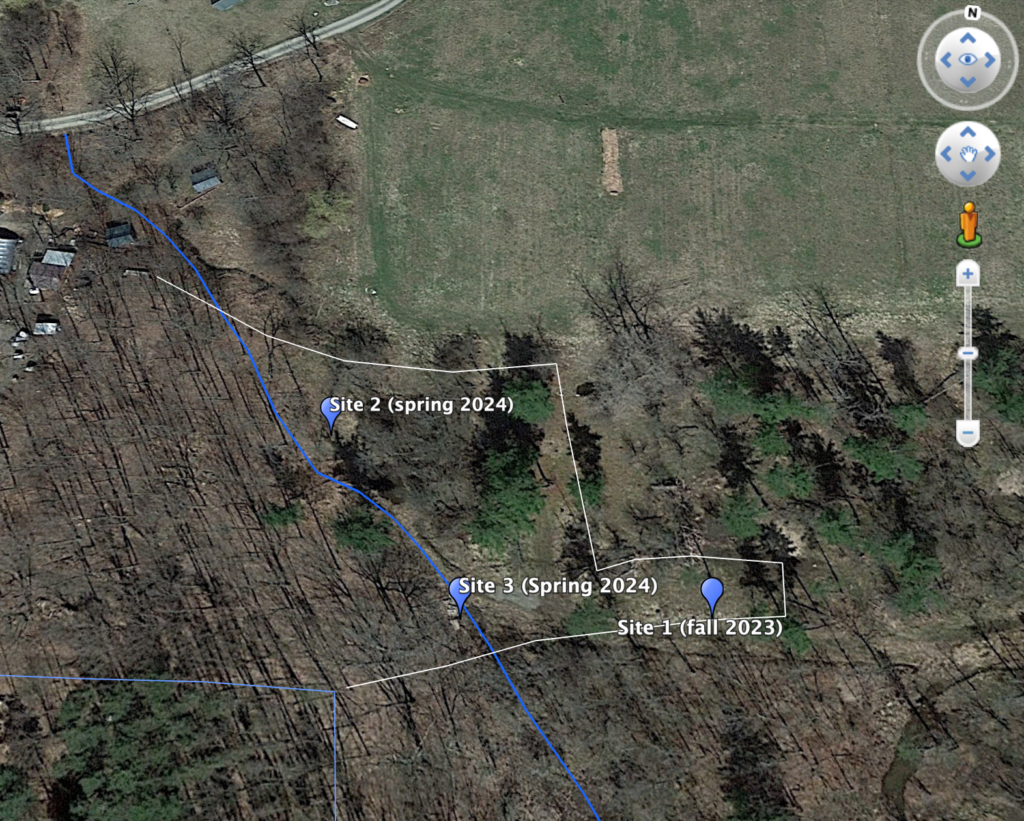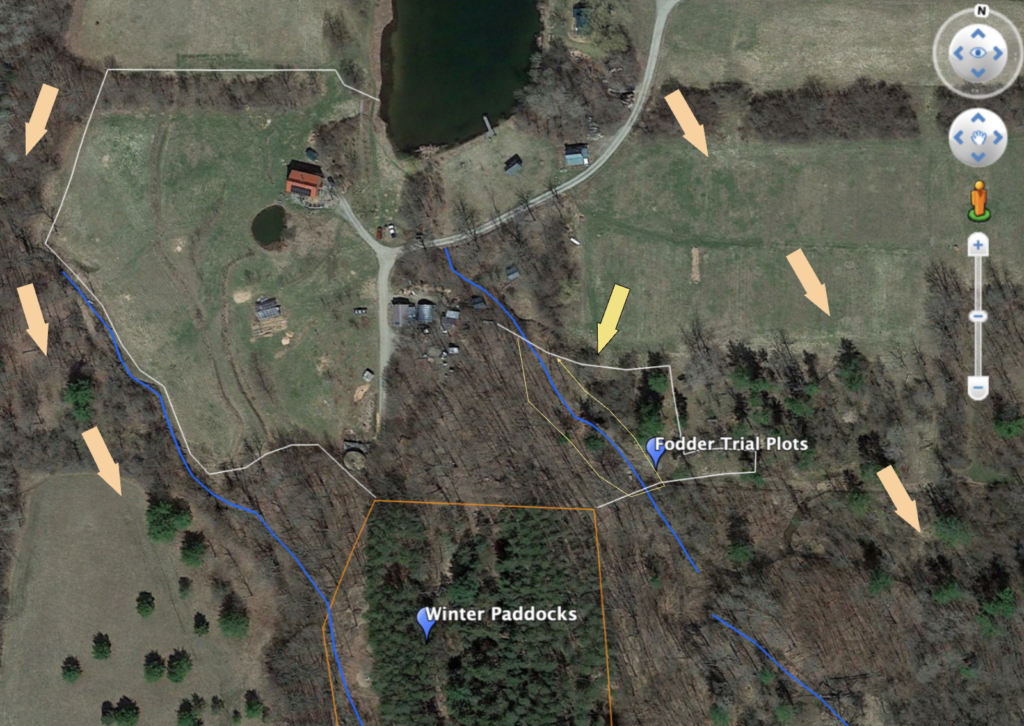Progress report for FNE22-010
Project Information
This project seeks to answer two questions:
1.What is the cost and benefit of producing tree plant material on the farm vs purchasing it in?
2.What intensity of site preparation and tree protection is necessary for trees to thrive in a fodder block?
Objectives:
1) Harvest local sources of willow and poplar varieties to propagate in an on-farm nursery.Compare costs and growth rates with cultivars available from commercial nurseries.
2) Prepare three planting blocks with varied intensities of site prep before planting. Install fencing and mulch strategies for each intensity.
3) Monitor and measure percent survival, growth rates, herbivory damage, and presence of disease for each tree monthly for two growing seasons
4) Compile data and report on costs in time and materials for establishing each combination of acquiring plants and site prep intensity
5) Develop a guidebook summarizing the findings and recommendations for farmers who are installing tree fodder blocks. Share publicly via online webinar and field days in 2023 and 2024.
The findings from this effort will provide other farmers with a better understanding of howdifferent potential outcomes from these strategies contribute to success of plantings and keep costs down, thereby, reducing their risk and making decisions easier.
The concept of tree fodder is an intriguing and exciting aspect of a holistic grazing system that can both benefit livestock grazing systems as well as meet environmental goals for small farms in the Northeast. Tree fodder blocks are dense plantings of trees that provide a strategic reserve of fodder for excessively dry, drought, or even overly wet conditions. Many species can be utilized, but Willow (Salix spp.) and Poplar (Populus spp.) are common staples.
With climate change emerging as a central challenge to maintaining good grazing forages for livestock, trees offer a critical solution to a future climate that is more and more unpredictable. One season may be excessively dry, and the next excessively wet. This leads to a lack of quality forage from traditional grass/legume/forb stocks, and unmanaged waterways (riparian zones) can flood and initiate pastures with excess water, sediments, and lead to erosion of these valuable pasturelands. The addition of trees to grazing systems (silvopasture) can provide shade, shelter, an alternative food source, and buffer many of the water issues present in farms throughout the Northeast.
Tree fodders are already established strategies in varying climates around the world (such as New Zealand and parts of Asia and Africa) that experience more challenging (excessively wet and dry) environments when compared to the historic trends in the Northeast. They are a clear strategy for increasing the stock of reliable food sources for animals in both wet and dry seasons, as woody plants and trees tend to be better adapted to these variable conditions.
While the nutritional and medicinal value of willow and poplar as tree fodder is well established in research, the process to effectively establish meaningful plantings on Northeast farms is relatively unknown. Questions remain about cultivar selection, seedling development, layout design, soil prep, planting, and protection of young seedlings with the specific purpose of providing reliable tree fodder for the farm.
Utilizing willow, and poplar in a riparian tree fodder block establishment has the potential for a win-win scenario that benefits not only the livestock but also the larger farm ecosystem. More specifically, many farms in the region have neglected and/or ignored riparian (water) pathways that would benefit from buffer plantings. Rather than grazing livestock right up to the edge of (and often within) a waterway, tree fodder blocks can offer an excellent solution to provide productive vegetation for livestock whilst also protecting the water way. The contribution of tree fodder to the livestock enterprise incentives the farmer to manage a riparian buffer. These areas often border pasture and if strategically developed, can provide an easily accessible source of fodder just outside the fenceline.
Even while the agroforestry practice of silvopasture is well documented as providing benefits to farm ecosystems and the productivity of livestock, adoption remains low. This is in part due to farmer unfamiliarity with tree planting and establishment, and in part because there is too much risk in experimenting with strategies to ensure an investment in trees pays off. Moreover, while techniques are well established for individual tree planting, there is not a well articulated process for specifically installing tree fodder blocks effectively and with efficient use of labor and materials. The Northeast needs “turn key” solutions for tree establishment that can work in many farm contexts. This project aims to test several pathways to success and report back on the best practices for establishing tree fodder blocks.
Our project builds off of previous research on our farm to document the nutritional value of tree fodders by testing several tree establishment processes to determine their costs and effectiveness on tree survival and growth. Successfully established fodder blocks will provide the farm with a sustainable source of nutritious and medicinal forage, especially for resilience during periods of drought. While growing, the trees will support water quality and mitigate negative effects from flooding. Results from the project will be applicable in many northeast farms, and can offer a template for success in other locations.
Cooperators
- - Technical Advisor
- (Researcher)
Research
Objective #1:
On farm and local sources of 3 willow and 3 poplar varieties will be identified in March 2023 and 40 cuttings taken from each of the 6 varieties (300 total). Cuttings will be between ½” and ¾” thickness and cut to 12” long. Cuttings will be stuck directly into irrigated nursery beds at a 4”- 6” spacing and mulched with sawdust. Labor hours and material costs for this will be recorded while the cuttings are monitored during the 2022 growing season. 18 of the best performing cuttings of each variety will be lifted in April 2024 and planted into each of the three fodder research plots so there are 6 replicates for each plot (54 trees total).
Commercial sources of 3 named willow and 3 named poplar varieties will be ordered (30 of each or 180 total) to plant alongside harvested farm stock in Fall 2023 or Spring 2024, as conditions allow. Costs of these trees will be recorded. Each tree will be given a unique identifier and tagged with a metal horticultural tag for data recording purposes. There will be 6 replicates of 6 varieties (3 on site and 3 purchased) for two species, willow and poplar, in 3 test plots (low / medium / high intensity) for a total of 216 trees planted into research plots, with 72 trees per plot.
Trees will be planted on a 3’ x 3’ spacing and randomized in their arrangement within the plot. All trees will be dipped in a beneficial mycorrhizal root dip and planted with a tree spade to a depth appropriate to their root growth.
Each plot will encompass a space that is 40 feet by 50 feet or 2,000 square feet of planting space, which allows for 12 rows of 6 trees at the above spacing. Given the variability of the riparian areas the plots may not be perfect rectangles but will contain the above parameters within +/- 100 sq feet. See the attached map for proposed test sites. Plots will be prepared in 2022 prior to planting, using machinery to address water erosion issues if present.
Once both sets of trees are planted, growth rates will be measured for each tree once per month from May 1 through October 1 for 2023 and 2024, along with recording survival and any observations on pest or disease issues. Growth will be measured in cm and recorded.
Objective #2:
Each test plot will have a soil test conducted annually in the Spring of 2023, 2024, and 2025. Beginning In April of 2023, two of the three plots will be prepared for planting in 2023. Some previous erosion and disturbance in the treatment areas will be addressed with an excavator before plot prep.
The low intensity plot will be prepared just before planting in April 2024, where the site will just be mowed/week whacked prior to planting. The medium plot will be mowed/weed whacked and then covered with high density tarps for one year. The high intensity plot will be mowed/weed whacked and then tilled with BSC with an amendment of on-farm compost added and then mulched to a 3” depth with hardwood wood chips. (See table 1)
Fencing to prevent deer damage for each plot will be installed directly after planting in Spring 2024. For the low intensity plot, 8 foot T posts will be installed every 10 feet and three strands of non-electrified strand will be stung with flagging draped every three feet as a deterrent. The medium intensity treatment will include the installation of a “3D” fence system that includes one fence set at 6 feet tall with two strands (top and bottom) and a second run of fence set 3 feet outside the perimeter of the first fence at 4 feet with a single strand that runs 2 feet off the ground. All strands on the 3D fence will be electrified using energizers and baited for 2 months after installation. The high intensity plot fencing will consist of Premier One’s 19/68/2 Anti-Deer netting (two rolls) installed and electrified.
Mulching for each plot will follow planting as prescribed. For the low intensity plot, no mulch will be added and competing vegetation will be weed whacked 1 - 2x per season if and when vegetation gets at least 10 - 12” tall. For the medium intensity site, sawdust will be applied as mulch at a depth of 4 - 6”. For the high intensity site, 2 - 3” of fresh wood chips will be added at the time of planting.
|
LOW |
MEDIUM |
HIGH |
|
|
Site prep / planting |
Mow or weed whack before planting |
Tarping for 1 year before planting |
Till / compost / mulch |
|
Browse Protection |
Single strand fence |
3D fence |
Premier Deer fence |
|
Mulch |
None, weed whack 1 - 2x per season |
Sawdust |
Woodchips |
Table 1: Summary of plot treatments
Objective #3:
Once the three plots are established, the bulk of the remaining work will be to monitor and observe the survival, growth rate, and any pest or disease issues that arise in the plots. Each plot will be visited weekly for observations, which will be recorded as qualitative findings along with any documented evidence of animal presence on the trail cams. Once per month each tree will be measured for growth rates and recorded as quantitative findings. Each plot will be equipped with two trail cams to capture any activity from deer. Observations and data collection will occur from May 1 - October 1 in 2024 and again in 2025 during the same timeframe.
Objective #4
As data collection is completed for each phase, we can complete analysis. Our assumption is that any benefits for site prep and mulching will be reflected in tree survival and growth, while the browse protection in our assessment of damage to the plants. While we recognize we are compounding variables in this approach, we are not seeking to isolate any one aspect of tree establishment but rather explore the relationship of investing time versus money into a particular approach intensity. Some combination of these efforts may prove reasonable, for instance if deer browse is low in all plots but growth rates correlate to soil prep, a less intense method of fencing could be recommended as a conclusion along with a more intensive approach to soil prep. We will be able to break out labor and material costs for the different aspects of the treatments also, so we can utilize a wide variety of combinations in our reporting.
Objective 5:
Following analysis our project team will draft and develop a research guidebook of 5 - 10 pages that summarizes the efforts with pictures and graphics and breaks down our learning both in the quantitative data and qualitative observations of the project as experienced by the participants. This brief will be published to our websites (farm website and SilvopastureBook.com) and shared during outreach activities, described below.
The start of this project was delayed this year (2022) for two main reasons; 1) we encountered issues with our plans to restore the creek bed before planting fodder blocks because of slowdowns working with local NRCS / Soil and Water agencies, and 2) the outbreak of the Spongy Moth (Lymantria dispar) caterpillar led to almost 100% mortality of our willow cuttings. We'd never experienced such a devastating loss, as usually cuttings are quite easy to produce in previous years.
As a result, we asked SARE to delay our end date and allow us to just push all research and activities back one year. We have changed the date in the above description to new targets.
We did successfully collect cuttings and develop a procedure for starting them in "air prune" beds, which were also constructed and tested. This nursery elements proved to be a marked improvement over previous methods of propagation of cuttings (in ground beds)-- while almost all of the willow and poplar suffered at the hands of the spongy moth, we had elderberry cuttings in the beds that thrived and produced impressive root systems. We do think this will allow for a good strategy to propagate willow/poplar for next year and allow for healthy root growth.
According to pest experts, the spongy month epidemic in our area should subside next year, as the cycle of intense impact of the population explosion tends to two years, and 2022 was the second season. Even still, we will plan on extra monitoring and treatment if necessary of the beds (using Bacillus thuringiensis kurtaki (Btk) approved in Organic production)
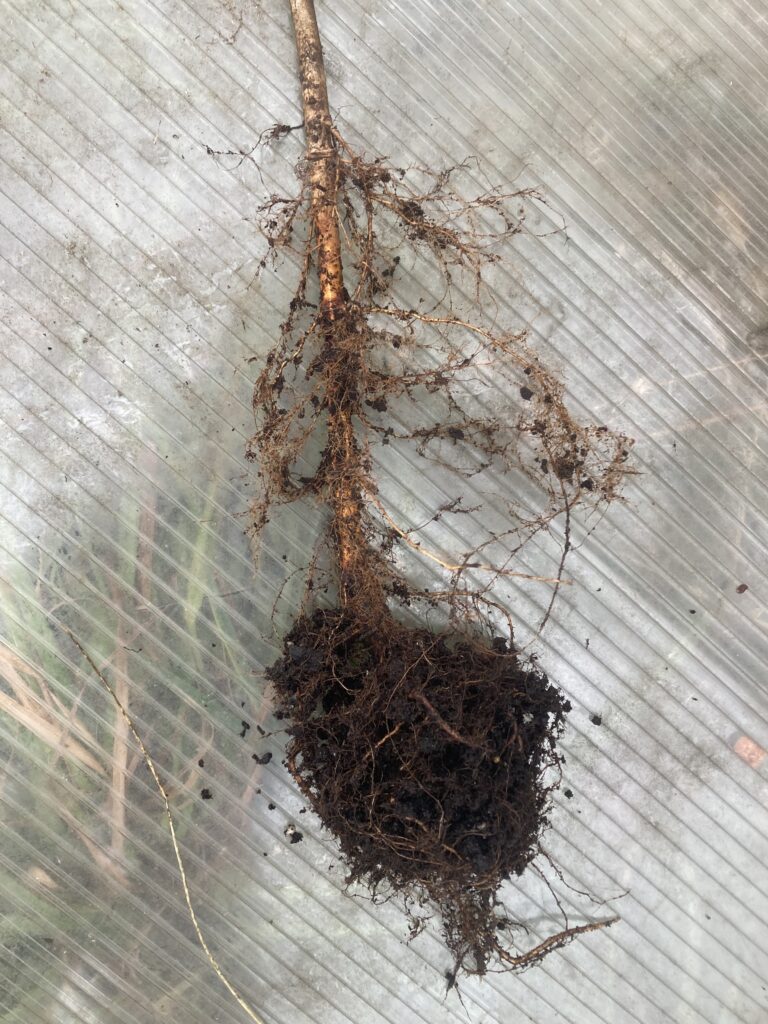
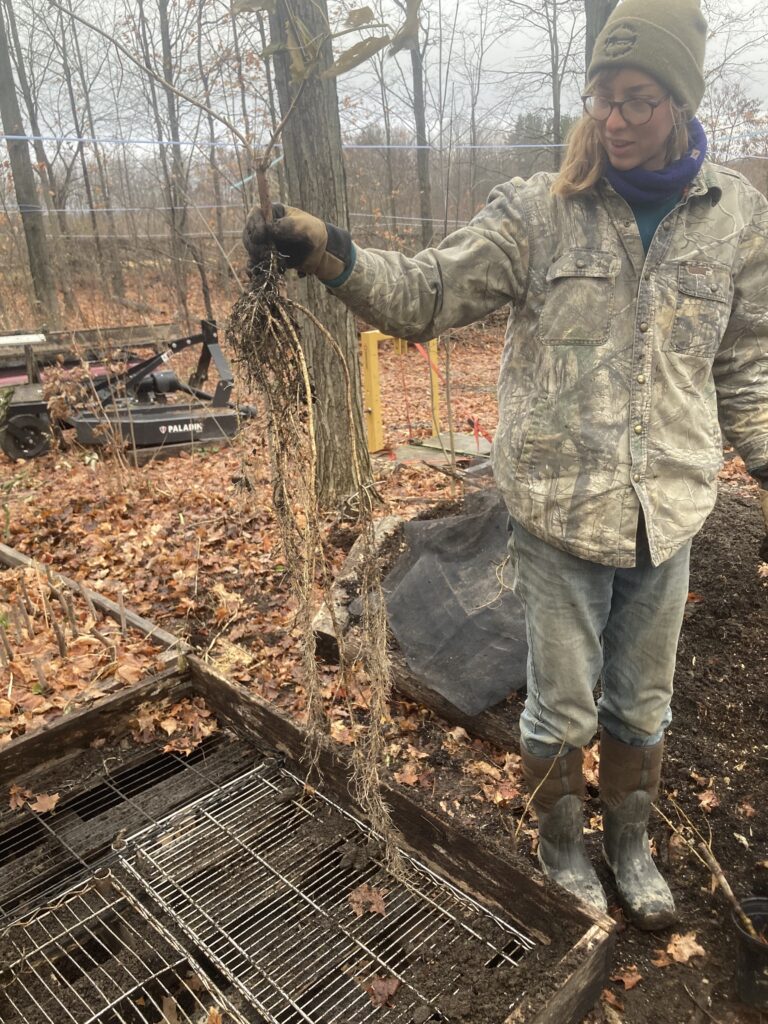
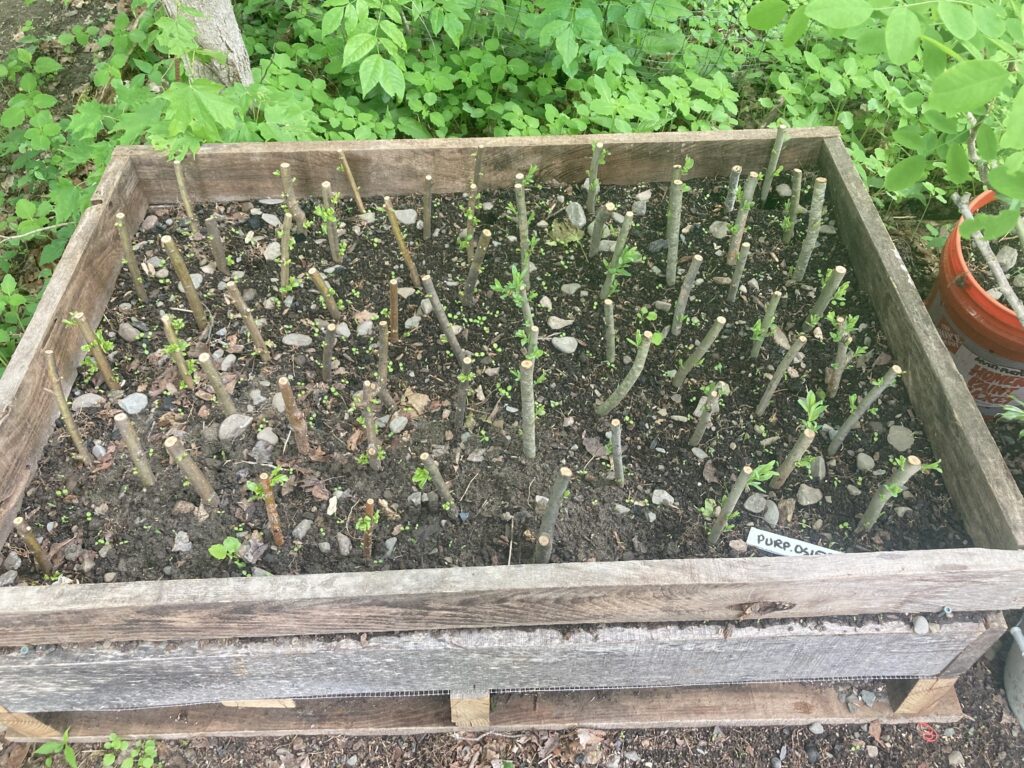
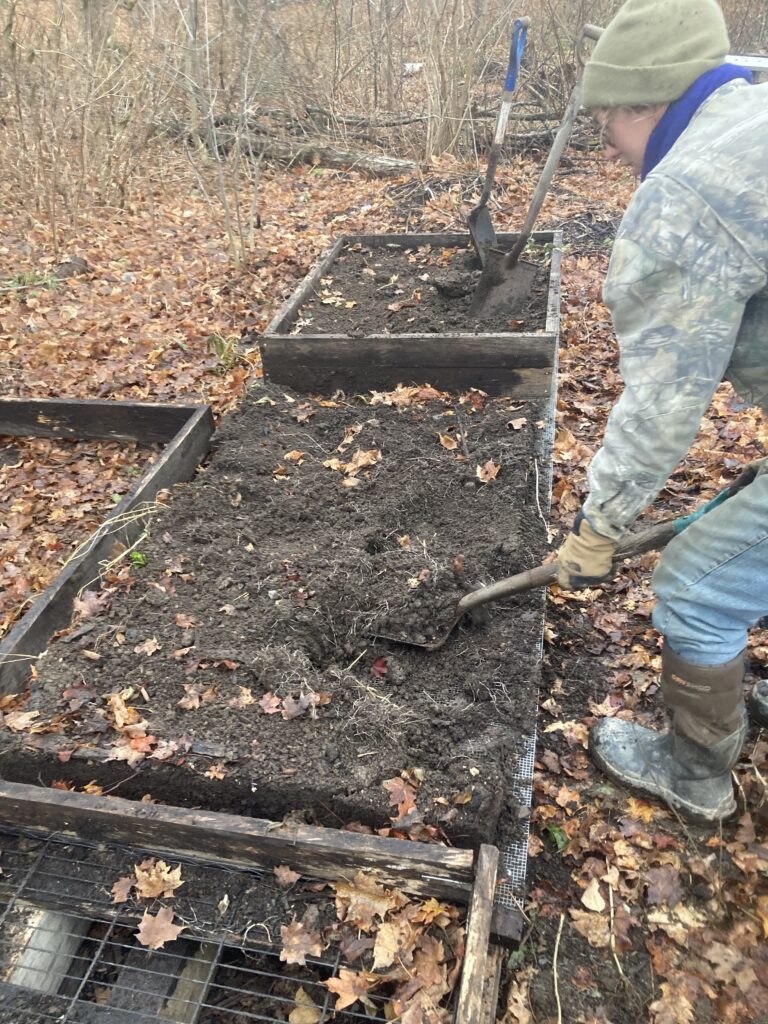
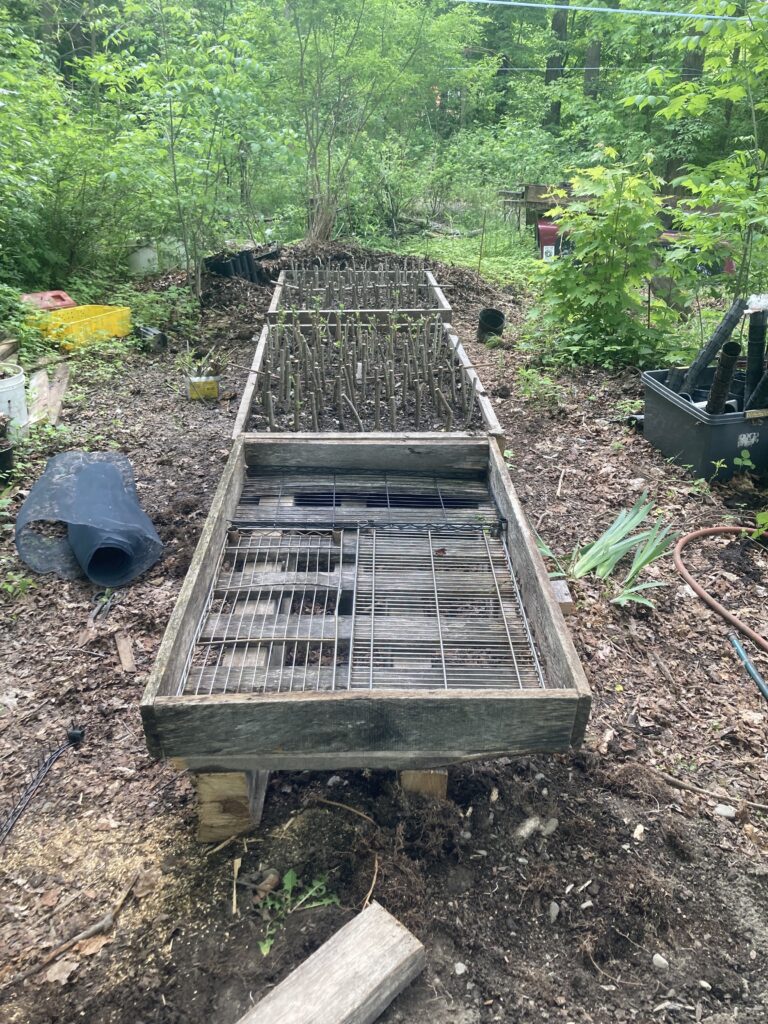
2023 Update
For this season, we took cuttings of willow and poplar from the farm landscape and also local known cultivars of willow and unknown varieties of poplar. We planned to match this effort with the cost of purchasing cuttings, which we did from Vermont Willow Nursery (average cost of $2.90 per cutting) and hybridpoplars.com (average cost .56 per bud cutting).
Unfortunately, the ordered stock did very poorly in our rooting beds both in the field and woods, with near complete mortality, while the cuttings we took did quite well. Some combination of management from the suppliers (cuttings are often stored in a cooler or freezer for a long time?) and our management (we didn’t get everything out into the beds as quick as we’d have liked) probably led to this high mortality. The Poplar trees were received in early March but sat in our cooler (packed in wet peat) until the end of the month. The Willow was ordered in March but didn’t arrive until late April, so may have experienced more stress in storage at the source farm.
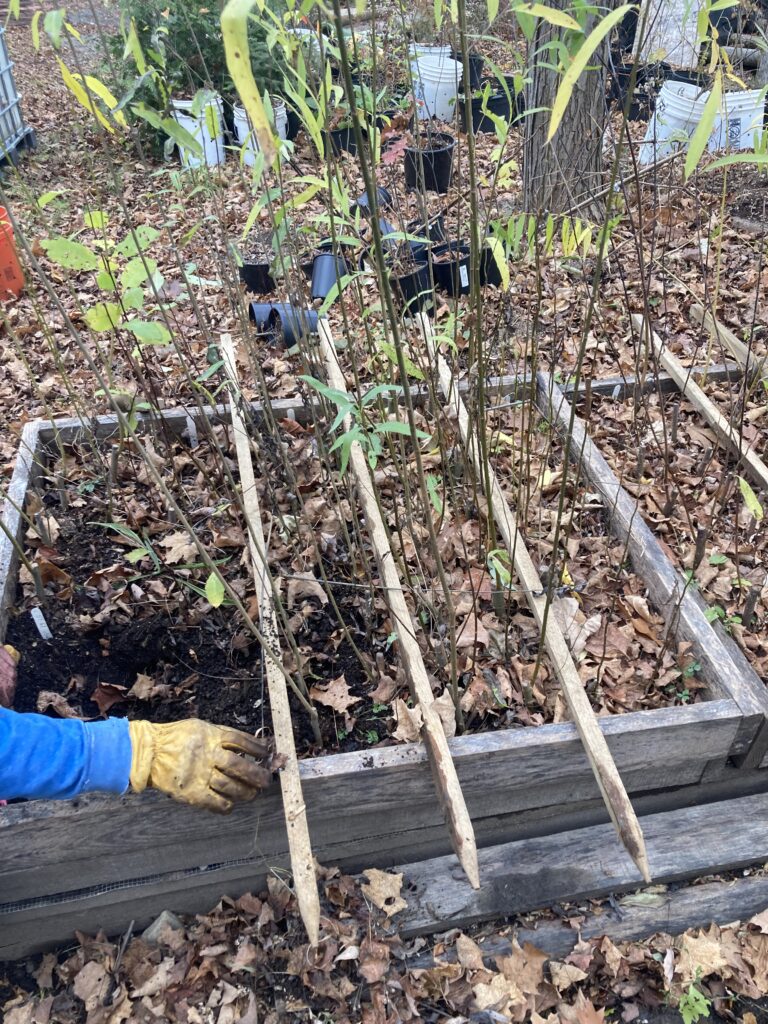
Thus, as the season progressed and we could see the purchased stock wasn’t going to thrive, we had to pivot our plan to plant a mix of poplar and willow to just willow, but we expanded from the original 6 varieties (3 willow / 3 poplar) to include 9 varieties of willow we had also growing in the nursery, for other uses on the farm. We are working now with these varieties in our fodder plots. We don’t see this change as problematic since we are working to discover viable establishment strategies of fodder blocks and learning from the process along the way.
|
Common Name |
Latin Name |
Source |
|
Purple Osier |
Salix purpurea (Streamco) |
Wellspring Forest Farm |
|
Flame |
Salix 'Flame' (Wild hybrid) |
Wellspring Forest Farm |
|
Austree |
Salix matsudana X Salix alba |
Wellspring Forest Farm |
|
Weeping |
Salix babylonica |
Wellspring Forest Farm |
|
SX-61 |
Salix sachalinensis |
Food Forest Farm |
|
Goat |
Salix caprea |
Food Forest Farm |
|
Rubykins |
Salix koriyanagi |
Food Forest Farm |
|
Curly |
Salix matsudana |
Wellspring Forest Farm |
|
Schwerinii |
Salix schwerinii |
Food Forest Farm |
Local cuttings were taken in the last two weeks of March, and stuck immediately into beds. We prepped in our field near the greenhouse, as well as in our air prune beds in the “woodland nursery.” We did this to provide a buffer of options in case something went wrong. We were thinking more in anticipation of possible drought, which might stress the field cuttings, but in fact the major event was a very warm April that led to a lot of quick leaf out of the cuttings, followed by a very devastating hard frost on May 17, where it was recorded to drop to 23F at our greenhouse weather station. The combination of rapid leaf out from the oddly warm spring and this event dealt a devastating blow to the cuttings in the field planting, yet the cuttings in the forest nursery were less harmed and recovered almost 100% across the planting.
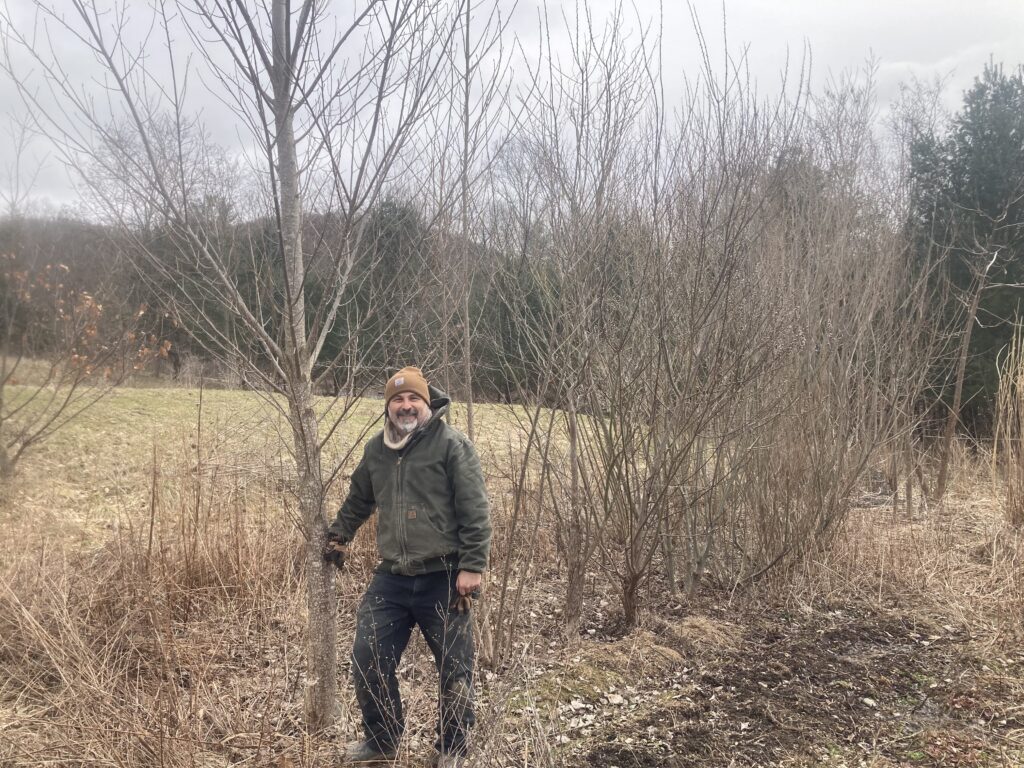
This spring, we also did site analysis and prep, sampling the three planting sites on 4/5/2023 and receiving results from the DairyOne lab for each site. All three sites have low Phosphorus (common on NY pasture lands) and high levels of K, Ca, and Mg. The pH for all sites was around 6.2 - 6.4 so suitable for willow, the most notable outlier was that each site had relatively high organic matter with site A at 8.2%, site B at 11.3%, and site C at 9.2%.
Site prep included excavator work in April, to address water flow issues in the B to C area and mowing site A. Some adjustments to the original plan to differentiate site treatments was necessary due to some unexpected characteristics the sites presented. We were able to tarp Site A on August 7, which was sufficient after 3 months to remove and plant. We decided against tillage in any of the sites because the wetness of the soil didn’t allow for a BCS to work effectively. And instead of three distinct fencing systems, we decided to focus on a perimeter 3D fence that encapsulated the three sites, since we were also installing a 3D fence on the other end of the farm as part of another agroforestry tree project.
|
Site A |
Site B |
Site C |
|
|
Site Prep |
Tarping |
Excavate and Berm |
“None” (topsoil spread) |
|
Fence |
3D perimeter |
3D perimeter |
3D perimeter |
|
Mulch |
Woodchips |
Sawdust |
None/Weedwhack |
A major factor in decision making this season was the substantial and persistent rain we experienced after a six week dry period in April and May. The cuttings looked well developed in Fall and so we prepared to plant out the sites. We were able to plant out Site A on November 10, but Sites B and C were heavily disturbed due to a new water line that was being installed. While we hoped the soil would dry out enough to plant, ultimately we decided it was best to wait to plant out the remaining sites in Spring 2024 and cover the remaining cuttings in the nursery with a deep bed of wood chips to protect from freezing temperatures. The 3D fence was fully completed and working with 8 - 10k volts but December 5, after much troubleshooting!
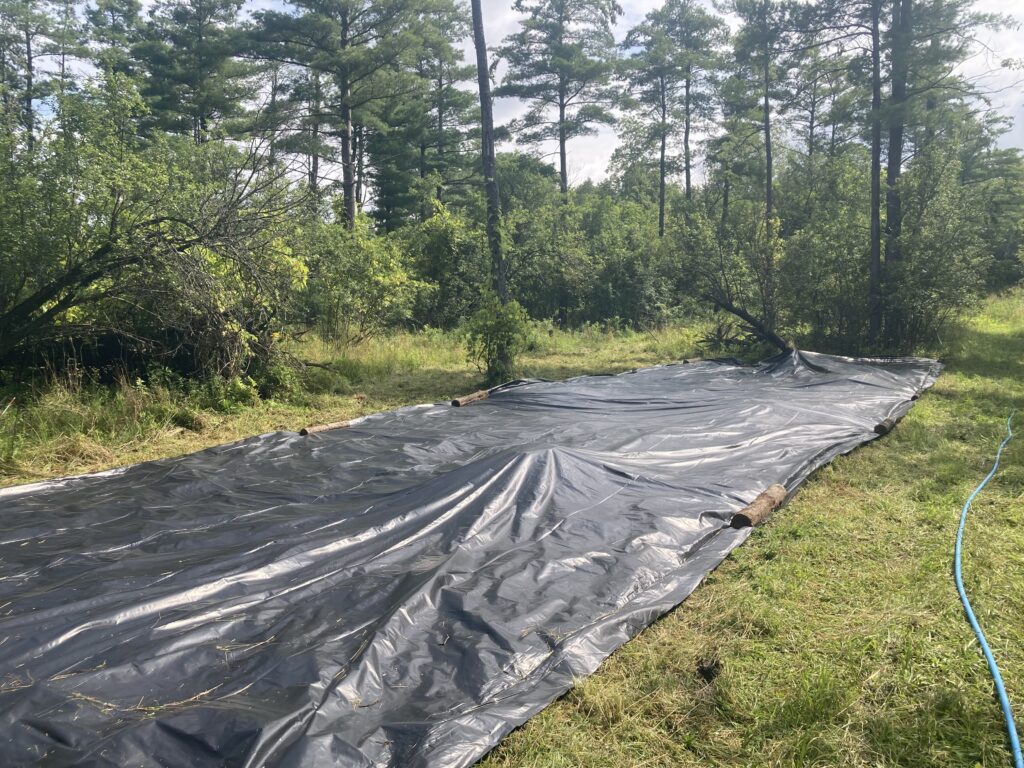
Outputs
In addition to the field work described above, we are working on some materials that will be part of the final share out of the project.
Initial database/literature review of Willow; we are working with Jeff Piestrak of FLX Agroforestry Solutions to review existing research and develop profiles of willow as a fodder species and and specific information on the cultivars we’ve settled on using
3D Fence Article: We have a draft of an article describing our process of planning and installing a 3D perimeter fence to reduce deer pressure on tree plantings. We’ve learned a lot or valuable lessons we are eager to share with others so they can save time and money if they choose to install one. Overall the fence is working well as a deterrent.
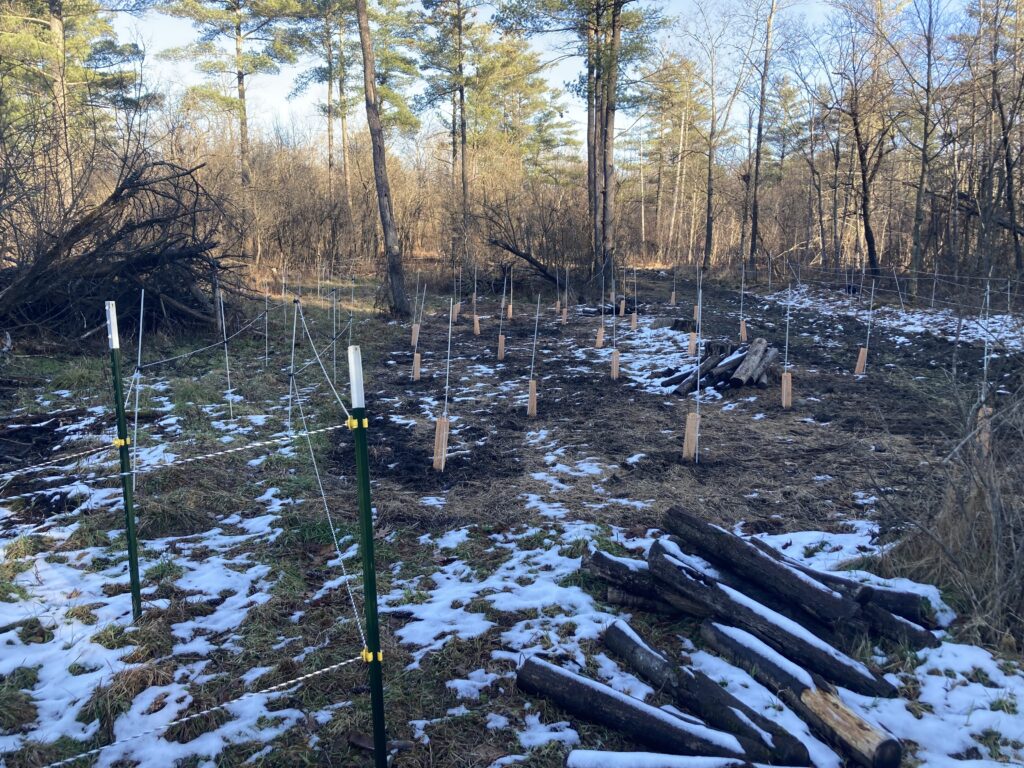
Key Learnings
- The Austree and SX-61 hybrids far outgrew other cultivars in year one
- Goat willow seems like a promising and desirable fodder species but is also slow growing initially and needs extra tender care to thrive
- Sourcing material locally (including having a friend who had cultivars grown out) was much more cost effective than purchasing plants, especially when considering the high mortality of the purchased stock. In a few hours we had more material that we knew what to do with, and cuttings were easily less than 10 cents a piece, vs .50 - 2.90 purchased. The biggest advantage of locally sourcing is the control one has to the timing of the activity to keep cuttings fresh and viable.
- Dormant hardwood cuttings are vulnerable to the variable spring thaw/freeze/warm weather conditions and that woodland nursery settings might buffer some of these effects and increase survival rates
- Overall, riparian areas are wonderful opportunities for developing fodder banks of wet tolerant species such as Willow. But, with the natural water dynamics of these zones, coupled with the increased variability from the effects of climate change, means that development needs to be well timed, and even flexible, to plant out the space. Extra consideration to designing for water quality is foremost in importance, with the trees being a helpful follow up activity after the hydrology is addressed. Site B will be of particular interest, since we took advantage of the water line excavation and dug out substantial catches to slow water down and create berms for establishing the willow come Spring, 2024.
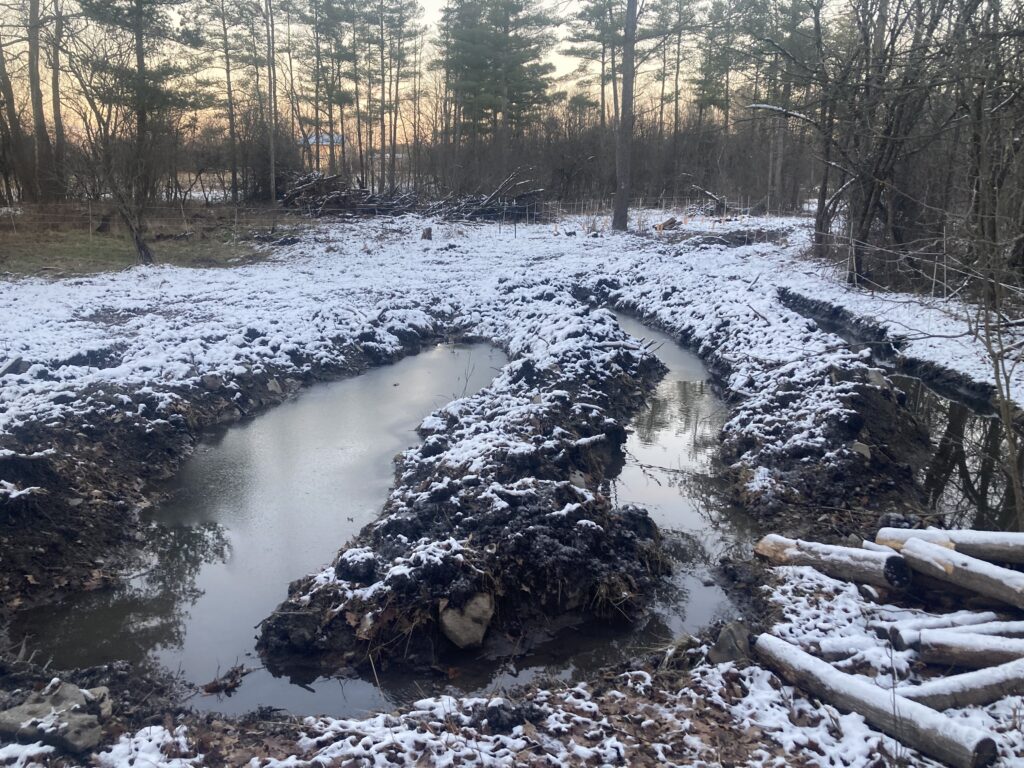
2024 Update
This season we have been able to successfully establish all three sites with randomized and rooted willow cuttings. We are happy to report this milestone to have the trees in the ground and growing.
Additionally, we acquired three additional species of larger diameter stakes from our technical advisor and decided to advantageously plant these along the edges but outside the “official” zone of the research. These varieties were recommended as being robust, producing ample vegetation, and growing quickly. One clear distinction is that we planted these in clusters of about a dozen “live stakes” spaced about 3 feet apart, using material that was around 1” in diameter. Given the wet winter that continued into spring, these stakes initially did very well, as did the plantings we established in Sites 2 & 3.
|
Bretensis |
Salix alba 'Britzensis' |
|
Gigantica |
Salix Aquatica Gigantea Korso |
|
Miyabeana |
Salix miyabeana |
Additional “clustered” willow added to the sites in 2024
While we had planted Site 1 in the previous Fall after removing the tarps, as noted last year the conditions were not favorable for planting the other two sites, because of excessive rain, the need for the excavated site to “rest” and settle, and the onset of colder than expected temps in November 2023. This provided a good opportunity to assess our progress and plan for a spring establishment of Sites B and C, respectively. This also gave us a second winter to test and assess the efficacy of the 3D fence before planting out more trees.
Further, we continued to reduce the variability of the plots, since it proved difficult to see how we would effectively mulch and maintain plantings with the items originally listed above (sawdust / wood chips / weed whack). It's safe to say that a huge learning from this project is the necessity to streamline activities for site prep, protection, and maintenance of plantings. We’ve landed on a helpful strategy to get trees established and maintain them cost-effectively, as follows:
1) Conduct site prep one season in advance, no matter the method.
2) Establish a 3D fence in advance of plantings, to encourage deer to re-route (more on this below) before establishing plantings.
3) Plant stakes that are ¾” or less in air prune beds for 1 - 2 seasons before planting. Stakes that are 1” or greater can be pointed at the bottom and driven in with a rubber mallet directly.
4) Immediately after planting, install a short tree tube and fiberglass stake to protect the base of the tree from burrowing rodents, and weed whacking. A taller stake also helps identify where the tree is if vegetation gets out of hand.
5) Weed whack strategically with timing, first at the end of the spring flush of growth (late May into early June) and then in late July/early August before anything gets too woody. Doing this at the right time drastically reduces the time it takes to complete the task.
The summary of plots has been updated below to reflect these learnings. Site C should be noted as having an additional activity that was unplanned when this project was conceived; we had a forestry mulcher onsite in the spring and decided to reduce much of the overgrown, dying, “invasive” buckthorn that was growing in the overstory, since it was easier to manage before planting. This provided an interesting and dense layer of shredded trees that acted much like a thick mulch, but proved more difficult to plant into so soon after. If we could have waited a year it would have been more amenable, likely.
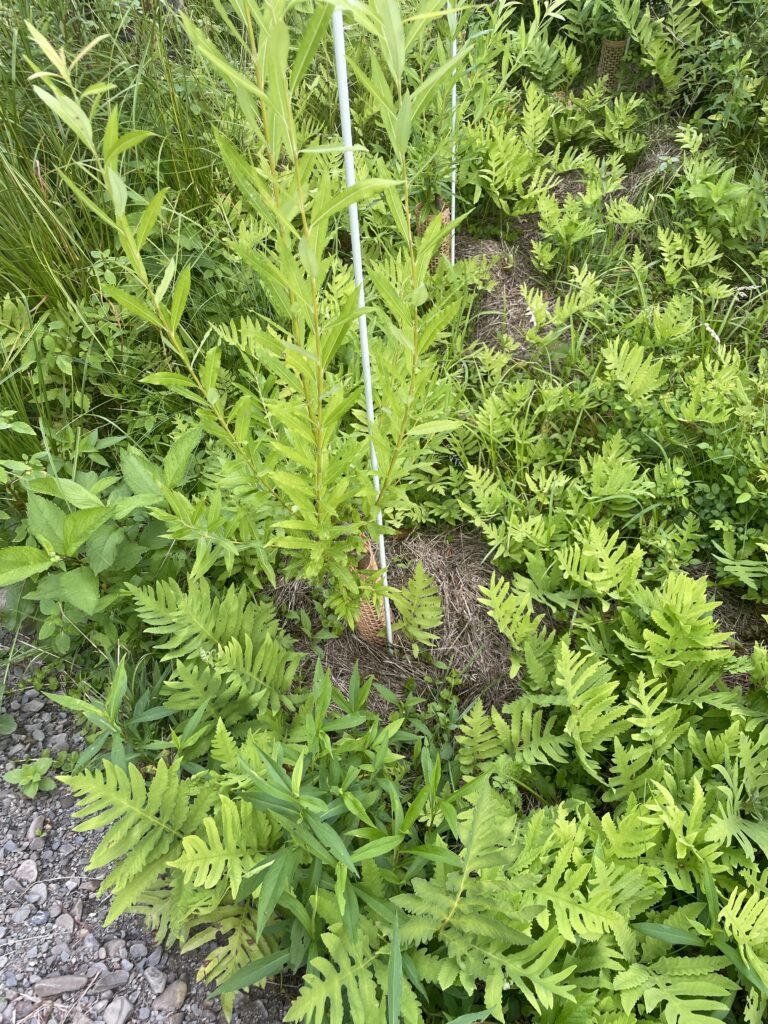
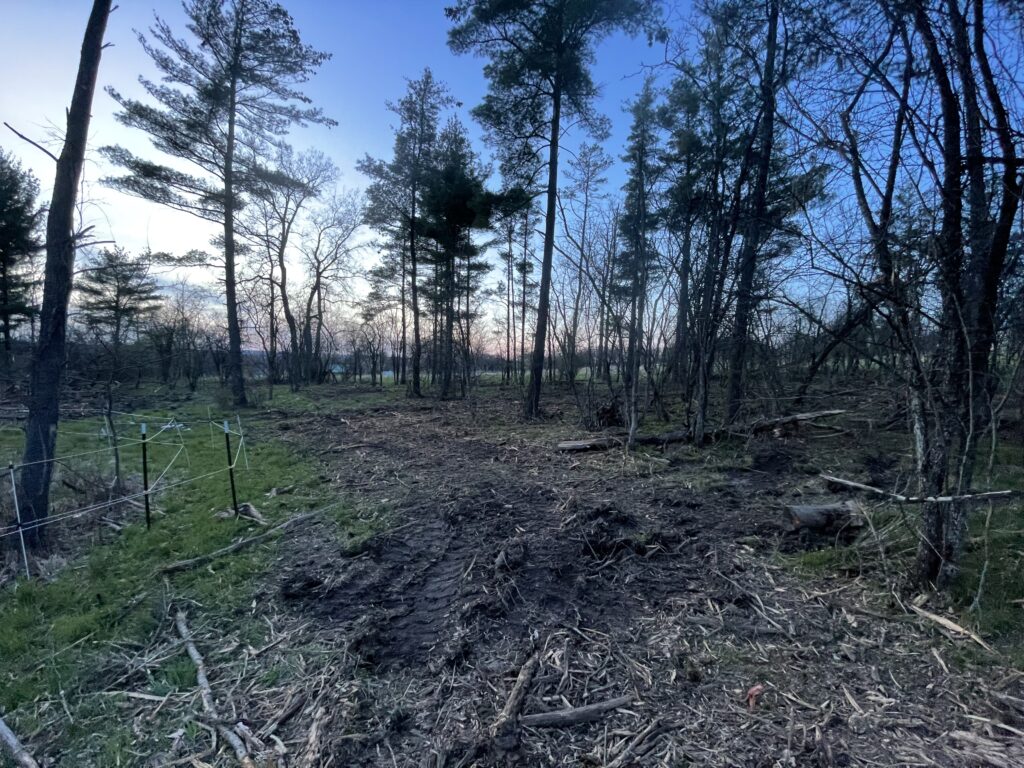
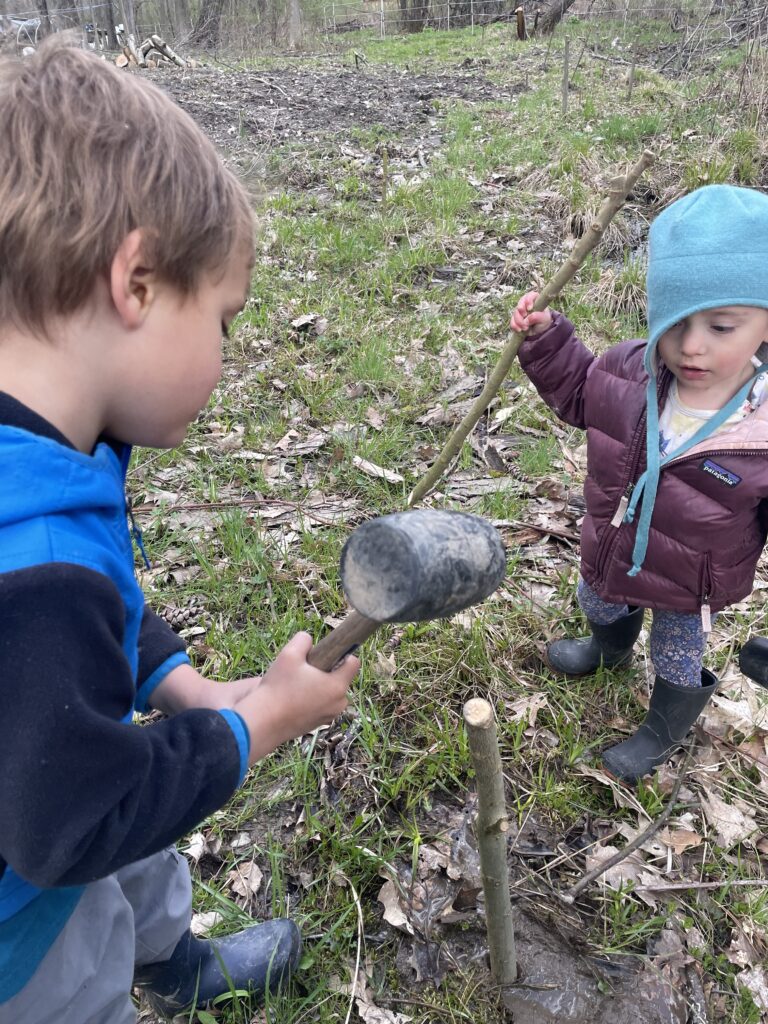
|
Site A |
Site B |
Site C |
|
|
Site Prep |
Tarping April - August 2023 |
Excavation and berming, Nov 2023 |
Forest mulching Spring 2024 |
|
Planting Date |
November 2023 |
May 2024 |
May 2024 |
|
Protection |
Short tree tube and fiberglass stake, perimeter with 3D fence |
Short tree tube and fiberglass stake, perimeter with 3D fence |
Short tree tube and fiberglass stake, perimeter with 3D fence |
|
“Mulch” / maintenance |
Weed whack in late spring after flush, late July before stuff gets too woody |
Weed whack in late spring after flush, late July before stuff gets too woody |
Weed whack in late spring after flush, late July before stuff gets too woody |
Updated table with treatments to the three plots
Notes on the Deer Fence
While we are working on a longer article describing the installation and maintenance of a 3D style deer fence as part of the project outputs, in the meantime some important notes to share in reporting include:
1) Changing patterns of behavior: It has become clear through the project that a 3D fence is a deterrent, not a fortress that will keep deer out perfectly. It has become necessary, then, to keep apprised about the actual specific deer that are interacting with a site and know their habits may change over time. In consulting for the project, we leaned on our neighbor who hunts out land to help describe the normal patterns of movement, noted on the map below (ORANGE). Rather than attempt to keep the deer out, what our plan of the fence aimed to do was encourage the deer to go around the planting zone, in order words stick to the outskirts and perimeter rather than cut through our field.
2) Given the changing nature of individuals and herds, along with the effect of seasonality, it became necessary to therefore conduct routine inspections of the fence for evidence of deer, as well as testing and keeping the voltage up. Fallen limbs, uprooted stakes, and lines grounding out on saplings were all discovered during (almost) weekly check ups we conducted from May - October. We treated these as a change to walk the land, in most cases taking less than one hour to complete.
3) When deer pressure was observed, action was taken to address it. In one instance, a corner of the fence (marked with a yellow arrow on the map) became an easy access for deer since they could get a running start and hop the fence. We addressed this by adding an additional loop of fence to the system (also in yellow) in October 2024 as well as felling a bunch of trees to discourage a good landing spot beyond the perimeter fence. This seems to have helped as the evidence of deer in the site was eliminated in the following weeks.
Still, even with these efforts we had some minor damage to willows planted, mostly the clustered “extra’ plantings we did. Yet since the deer may feel compelled to keep moving through the space, the damage was minor and we expect the trees to recover in the coming season.
All this to say, between the need to check on the fence to ensure it is operating at its top potential, along with the timing of vegetation growth to hit it before it become unwieldy, routine visits to the site and fence became necessary, and will continue to be so, until the majority of the willow is above browse height. Time will tell if this will happen in 2025, or beyond.
Notes on Measurements
In addition to the establishment goals for the project we set out to take measurement of growth, which we have done for trees in the nursery beds and after planting. Initially in the proposal we suggested monthly measurements but this proved too time consuming, and not particularly useful. So, we are shifting to simply annual measurements of growth (2023); from cutting to first year, and then for two seasons in the planting. (2024 and 2025). This should offer an average amongst the various cultivars that will provide ourselves and other farmers with good data to make future decisions.
Additionally, we have tracked the time and other costs associated with establishing willow in each of the three sites, which may prove useful when comparing the success of the different plantings. While the data won’t be completed and shared until our final report at the end of 2025, we can offer some initial observations of the plantings:
Generally, the trees planted in the excavated site (B) are growing faster and healthier than the other two sites. There is notable mortality and the trees are struggling most at site A, which may be a function of site prep (tarping), the timing of planting (Fall 2023), or some combination of these factors. The trees at site C seem to be doing initially pretty well.
We look forward to comparing the soils data, tree growth data, and observations from 2025 to see how these three sites compare at the end of the project.
Outputs
In addition to the field work described above, the following have been developed in 2024:
We built upon the initial database and literature review of willow and began outlining a guide to planting willow for Agroforestry, including information on collecting and care for cuttings, cultivar selection, site prep, and planting learned from this project.
We still have an evolving draft of the 3D fence article to finalize in the coming year and share as well towards the completion of the project.
Key Learnings
- Streamline the system: tree and fence maintenance is easy to fall down to the bottom of the list when so many other demands persist on the farm. It is necessary to find ways for these tasks to be achievable and routine.
- Size of willow matters: during propagation, staking material should be sorted for nursery growing versus direct planting into the field. Once growing, the race to get above browse height and become established helps reduce ongoing maintenance demands.
- Site prep is best a season ahead; When possible, the disturbance to a site takes time to occur, and time to recover from. Ideally a space of 6 - 12 months from site prep to planting seems best, at least within the context of the methods we have utilized so far.
- Deer fence needs vigilance: The 3D fence is a deterrent only if it's kept up, high voltage, and assessed for possible vulnerabilities on a routine (weekly?) basis.
- Excavation is doing best, overall; perhaps not surprising, the excavation site is proving to provide a really nice growing medium for the trees. It's not a stretch to imagine that hilling up two to four feet of rich soil would result in such positive outcomes.
Education & Outreach Activities and Participation Summary
Participation Summary:
This season was the first year we were able to show our process off to mostly fellow farmers, along with some extension and university folks, during three events. The Field Day was a direct event stemming from this grant, while the other offered more auxiliary opportunities to share our project with a captive audience.
Agroforestry Field Day, 9/20/2024 was a facilitated tour and discussion of all agroforestry activities on the farm, but explicitly focused on the willow fodder trials. (16 participants)
Tree Nursery Intensive, 10/19/2024 hosted 16 farmers and toured the willow plantings and discussed methods for propagation.
Coppice Agroforestry Workshop, 11/9 and 11/10, hosted 13 farmers and toured the plantings.
Project Outcomes
none, yet
